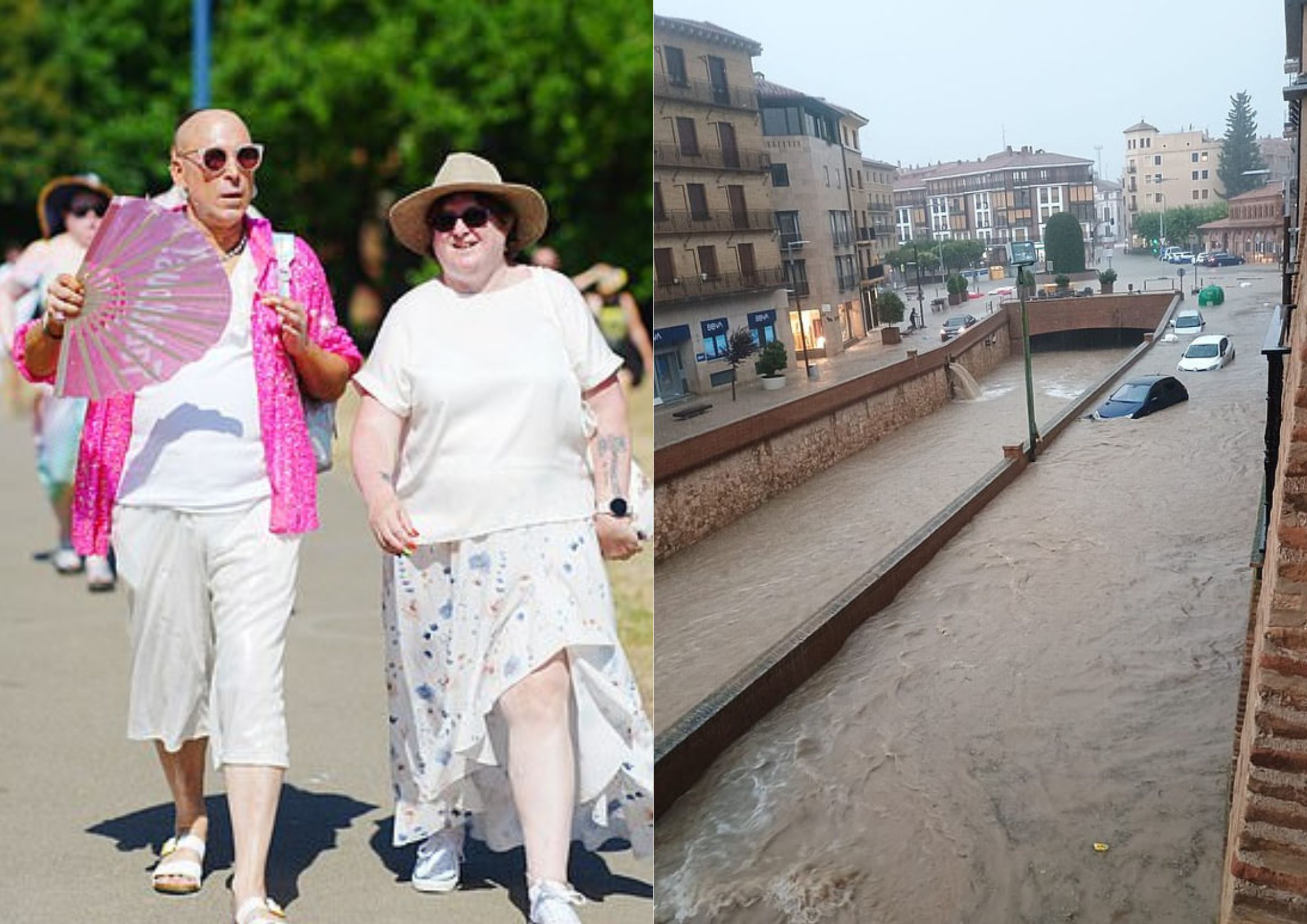While many people in the UK have been basking in summer sunshine, soaking up record-breaking temperatures, the situation couldn’t be more different over in Spain.
A severe weather front has brought chaos to some of the country’s most popular holiday destinations—just as thousands of Brits headed there for a sun-soaked escape.
Half of Spain on Alert as Storms Hit Hard
Spain’s national weather agency, AEMET, has placed 25 of its 50 provinces under official weather warnings, with eight regions under the second-highest alert level—orange.
Places like Zaragoza, Huesca, Teruel, Girona, Barcelona, Tarragona, Lleida, and Castellon are right in the eye of the storm.
Streets Flooded, Cars Swept Away
The intensity of the downpours has already turned streets into rivers.
In some towns, cars were spotted floating or getting washed away, and entire roads became impassable.
Tarazona, a town in the province of Zaragoza, was especially hit—receiving a staggering 100mm of rain in just one hour on Friday.
Authorities have since issued a red alert for the area.
Tourists Caught in the Middle
For tourists hoping to enjoy some Spanish sunshine, this has been an unfortunate turn.
Many are stuck in flooded hotels or experiencing travel delays, especially in storm-affected regions.
Public transportation has been severely disrupted, and properties have sustained heavy damage.
Spanish Military Called In for Emergency Response
To help manage the crisis, the Military Emergency Unit (UME) has been deployed to Zaragoza and surrounding areas.
They’ve already responded to more than 30 storm-related emergencies, including fallen trees and blocked roads.
Thankfully, no injuries have been reported so far.
Catalonia Braces for the Worst
Parts of Aragon, Catalonia, and the Valencian Community are expecting even more rainfall, with projections of up to 50 litres per square metre.
Catalonia has taken the step of issuing its highest-level weather warnings—levels five and six—indicating the likelihood of flash floods and dangerous conditions.
People in those areas are receiving mobile alerts, urging them to stay indoors and avoid flood-prone zones.
Already, 70 minor incidents have been reported overnight in Catalonia alone.
More Storms Heading Toward Spain’s Coasts
Later today, stormy conditions are expected to reach the Cantabrian coast, the Balearic Islands, and parts of central and eastern Spain.
Regions like Alicante, Valencia, Alava, and La Rioja are all under storm warnings as meteorologists monitor the shifting conditions.
Britain Deals With the Other Extreme: Scorching Heat
Back in the UK, the story is heat, not rain.
Parts of the country reached blistering highs on Friday, with Astwood Bank near Worcester clocking in at 34.7°C.
Saturday was forecast to be even hotter, with a potential peak of 35°C before temperatures begin to dip slightly by Sunday.
Greg Dewhurst from the Met Office explained that although Saturday might be the hottest day, temperatures will stay high through the weekend, with southern England seeing up to 31°C on Sunday and the southeast possibly hitting 30°C again on Monday.
Heat Alerts, Hosepipe Bans, and Fire Warnings in the UK
The sweltering weather has triggered amber health alerts across the Midlands, southern, and eastern England, warning that vulnerable groups—especially the elderly—could face life-threatening risks.
In response, six million households are now facing hosepipe bans, and fire brigades have issued warnings about wildfires and drowning risks as people flock to ponds and pools to cool off.
London, in particular, is under a “severe” wildfire threat according to the Natural Hazards Partnership.
Meanwhile, train passengers have been cautioned that the heat could cause weekend travel disruptions.
Spain’s DANA Storm: A Meteorological Menace
The storm system over Spain is being driven by a meteorological phenomenon known as a DANA—short for depresion aislada en niveles altos, or an “isolated depression at high altitudes.”
This kind of system pulls warm, wet air into the upper atmosphere, triggering intense thunderstorms, hail, lightning, and sudden downpours.
The current DANA is pushing unstable air from the north and east over the Iberian Peninsula, creating the volatile conditions now battering the country.
A Dangerous Reminder of Past Tragedies
For many, this weather event brings back chilling memories of the catastrophic flooding in Valencia last October.
That DANA claimed nearly 230 lives and became one of Spain’s deadliest weather disasters in modern history.
Back then, floodwaters swept through entire towns, trapping residents in basements, submerging streets, and forcing people to climb trees and lampposts to survive.
The scale of destruction made it the most devastating flood in a single European country so far this century.
What Comes Next?
Although much of Spain is currently enduring torrential rain and powerful storms, some regions—particularly in the southeast like Murcia, Alicante, and parts of Andalusia—are still facing extreme heat.
Temperatures there could soar to around 40°C before cooler air eventually moves in across mainland Spain and the Canary Islands.
Winds are also expected to pick up along the coastlines and islands, potentially causing further disruption.
For now, the best advice remains the same: stay indoors if you’re in storm-affected areas, and take precautions if you’re experiencing the heat.
Whether it’s blazing sunshine or flash floods, the weather is keeping everyone on high alert.
